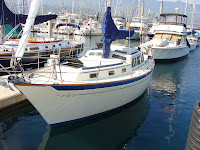This was a big weekend for us! It was our first multi-day trip and long distance race aboard Spray. On Friday morning, we left our Channel Islands slip at 6:00 AM, emptied the holding tank, and headed up the coast to Santa Barbara. The seas were calm and there was no wind so we powered the entire way at about 290 degrees according to our compass. Along the way we saw some large schools of dolphins feeding and playing. We also had a small green finch like bird fly along with Spray for over 30 minutes. Spray's virtually new diesel auxiliary engine moved us nicely at about 6.2 knots while turning 2,400 RPM. Charlie spent the entire time at the helm (since Spray's 30 year old Sharp autopilot is broken) while LeeAnne and Dean slept. We arrived in Santa Barbara harbor at about 11:45.
Once in Santa Barbara, we got our slip assignment from the Harbor master and moved Spay to the big boat berth behind S dock. We were the first of the Hardway racers to arrive so we had plenty of room. Our friend Tom arrived shortly after us and we helped him dock his boat on the end tie. We then met up with Tom's wife Kelly and headed to the marina for lunch at Brophy Bros Seafood restaurant overlooking the harbor and bay.
The next morning we got up early for breakfast at Minnows(?) and then visited the boaters swap meet. Charlie picked up a pair of nice Schaefer twin sheet Genoa blocks and a few stainless steel rub strakes. After all, you can never have too many spare boat parts! At 9:30 we attended the skipper's meeting for the Hardway race. The race committee split the non-spinnaker class into two groups. The A group had PHRF ratings <151 and the B group had ratings >=151. With a rating of 180, Spray was in the B group with three other boats, two of which had the same 180 rating! The wind was picking up and it looked like it would be a great day for sailing.




















































